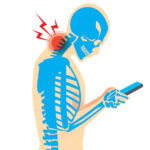You’re busy. Really busy. You’re juggling multiple responsibilities while taking care of yourself and your family. And you are probably using various pieces of technology, such as your computer, tablet and cell phone. But did you know that using those devices can come at a price to your health? They can even result in signs and symptoms similar to dementia? We call it digital distortion.
Technology is handy, but it takes a toll on your brain. That’s because there is a sensory mismatch in your brain from overusing technology while sitting in a slouched position. This causes under-stimulation of the areas in the brain. Areas that control things like reading, motivation, memory, proper posture, pain reduction, balance and joint sense.
Meanwhile there is over-stimulation in the visual center of your brain. It’s a lot like having a weak cell phone signal – in your brain.
In addition to digital distortion, other health issues develop from habitual use of electronic equipment like computers and cell phones. A new term has even been coined to identify it: Text Neck.
There’s no doubt that long periods of sitting increase the mechanical stress on spinal bones, ligaments, discs, muscles and other tissues. And that leads to degenerative changes in the spine and a deterioration of posture.
But this doesn’t just lead to pain and stiffness in your neck and bad posture, with your head sitting forward and upper back humped. It can present significant health problems, such as heart disease, metabolic syndrome, decreased concentration and focus, osteoporosis, and even increased cancer risk.
And those effects can occur in both adults and children.
What Can You Do About Digital Distortion?
The most obvious strategy is to stop or at least reduce the amount of time you spend sitting (more specifically, prolonged sitting).
It’s virtually impossible to not sit at all, so here are 4 quick and easy tips to help you get started.
- Take a break. Walk away from your workstation every 20 minutes. Set a timer on your phone, and commit yourself to getting up, walking around and stretching.
- Sit tall. While sitting, reach your head to the ceiling, keep your ears over your shoulders and your chin tucked in.
- Break the mold. Try a stand-up workstation, or trade your chair for an exercise ball.
- Get checked. Have a Corrective Chiropractor check your spine for any core problems that may be resulting from your technology habits and interfering with your health. Specific, corrective chiropractic care is an essential strategy to reconcile not only the postural stress of sitting but more importantly the cognitive stress of an under-stimulated brain.
If you’re already starting to notice the signs of symptoms of digital distortion in your, or your kids, we want to help. Click here to schedule a complimentary case review today.
Dr. Derek Gallant
Dr. Derek Gallant has committed himself to helping others live the best life possible. After graduating from Wesleyan University, he received his Doctor of Chiropractic Degree from Life Chiropractic College West where he finished 2nd in his class. He is the owner of Beverly Family Chiropractic and co-founder of The Well Family Foundation. Dr. Gallant is certified through the International Chiropractic Pediatric Association (ICPA) in the Webster technique, an analysis focused on assisting pregnant women in a healthy pregnancy and natural birth. He has inspired thousands of people to take control of their own health using the Life By Design method. Apart from full time practice you can find Derek at the parks and coffee shops around Beverly with his family, training hard at the gym, or at the beach surfing.








